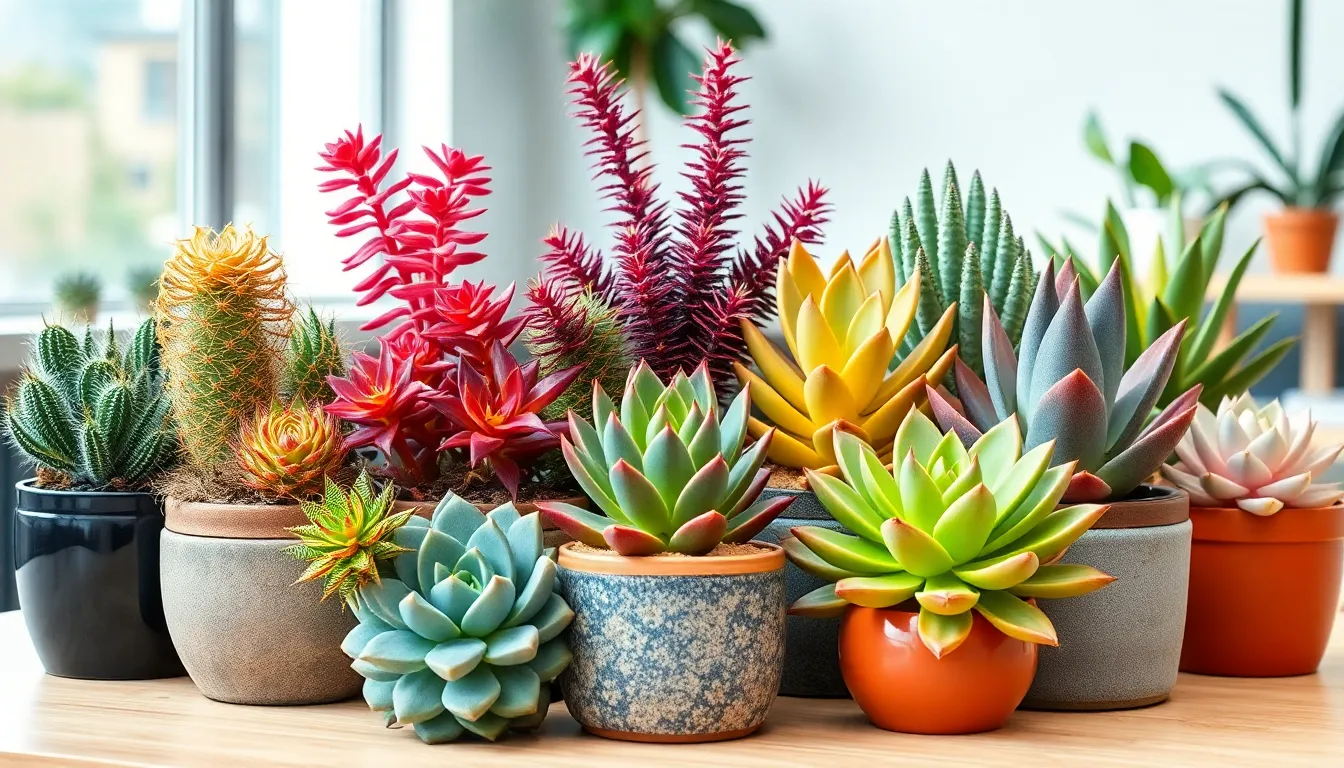
Exotic Succulents: Transform Your Space with These Stunning Houseplants
In the world of houseplants, exotic succulents are the rock stars that steal the show. With their quirky shapes and vibrant colors, these little green wonders can turn any dull corner into a botanical paradise. Who wouldn’t want to impress friends with a plant that looks like it just walked off a sci-fi movie set?
Exotic Succulents
Exotic succulents refer to unique species of succulents originating from various parts of the world. These plants showcase distinctive shapes and vibrant colors, enhancing their appeal as houseplants. Native to regions such as Africa, Central America, and Madagascar, they often feature unusual textures and forms.
Characteristics define exotic succulents, including thick, fleshy leaves designed to store water. Unlike ordinary houseplants, these species adapt well to different environments, requiring minimal care. Sizes can vary significantly; some grow tall and spiky, while others remain compact and rosette-shaped.
Diversity exists within the succulent family. Species such as Lithops, commonly known as living stones, mimic their surroundings to avoid herbivores. Another example, the Euphorbia tirucalli, known as the pencil cactus, presents a striking visual with its upright, pencil-like stems that add visual interest to any collection.
Availability remains high for exotic succulents in local nurseries and online marketplaces. Many plant enthusiasts seek them out for their rarity and aesthetic value. Care requirements typically include bright light, well-draining soil, and infrequent watering, making them accessible even for novice gardeners.
Growth rates of these plants often vary, with some thriving quickly under optimal conditions while others take their time. Integrating exotic succulents into home décor offers an opportunity to create captivating displays. By mixing various species, individuals can cultivate a visually appealing and diverse indoor garden that sparks conversation and admiration.
Popular Types of Exotic Succulents

Exotic succulents showcase stunning varieties that appeal to plant lovers. Each type offers distinct characteristics that enhance their allure.
Unique Characteristics
Lithops, known as living stones, blend seamlessly with their environment. Their unique shapes and colors often mimic the pebbles around them. Euphorbia tirucalli, also called pencil cactus, features slender, upright stems that create a striking visual. Haworthia, characterized by rosette formations, displays intricate patterns on its leaves. Agave species, with their architectural structures and bold forms, serve as centerpiece plants. Lastly, the colorful Crassula ovata, or jade plant, attracts attention with its thick, glossy leaves. Each species provides a distinct aesthetic while thriving in diverse settings.
Care Requirements
Exotic succulents thrive best in well-draining soil, promoting healthy growth. Bright, indirect light is essential, as it prevents leaf burn and promotes vibrant colors. Watering should occur only when the soil dries out, which is typically every two to three weeks. Fertilization during the active growing season, from spring to summer, supports robust development. Maintaining indoor temperatures between 65°F and 85°F ensures optimal health for these plants. It’s crucial to monitor humidity levels since these succulents prefer drier environments. These straightforward criteria make exotic succulents suitable for beginners and experienced gardeners alike.
How to Choose Exotic Succulents for Your Collection
Selecting exotic succulents requires careful consideration. It’s essential to match plant characteristics with individual preferences and growing conditions.
Factors to Consider
Different factors influence succulent choices. Light requirements vary among species; some thrive in bright indirect light while others prefer partial shade. Watering needs also differ; for instance, succulents like Lithops need less frequent watering compared to Crassula ovata. Pot size plays a role as well; larger pots retain more moisture, affecting root health. Growth habits should also factor in; compact varieties fit well in smaller spaces while larger succulents can serve as stunning focal points.
Sourcing and Purchasing Tips
Sourcing exotic succulents demands attention to quality. Reputable nurseries often carry a diverse selection, ensuring healthier plants. Online retailers provide convenience; however, it’s wise to check customer reviews before purchasing. Inspecting plants for signs of pests or disease helps avoid introducing issues into your collection. Timing matters too; purchasing during the growing season increases chances of acclimating plants successfully. Adopting these tips leads to a thriving, unique collection that enhances any indoor garden.
Displaying and Styling Exotic Succulents
Displaying exotic succulents enhances their vibrant features and unique textures. These plants thrive in various settings, whether as tabletop accents or window sill displays. Incorporating different heights and shapes creates visual interest. Grouping plants with contrasting colors, like the rich greens of Haworthia and the blues of Agave, provides a striking palette.
Using decorative pots can elevate the overall aesthetic. Choose pots that complement the color and shape of the succulents. Textured ceramic or sleek modern designs highlight the plants’ unique forms. Options like terracotta add rustic charm while showcasing proper drainage.
Arranging succulents in terrariums offers an enclosed environment that increases humidity. A mix of sand, small stones, and charcoal layers can promote drainage and health. Positioning succulents in layered terrariums creates a captivating display, revealing different plant heights and colors.
Consider adding accent pieces, like driftwood or pebbles, to fill empty spaces. This approach adds personality and depth to the arrangement. Brightening the space with decorative stones enhances the overall look while ensuring each succulent remains the focal point.
Lighting plays a crucial role in displaying exotic succulents. Positioning them near bright indirect sunlight encourages healthy growth and vibrant colors. Using grow lights can also supplement natural light, especially in dim areas. Regularly rotating pots ensures even light exposure, promoting uniform growth.
Finally, remember to keep maintenance in mind. Cleaning dust from leaves enhances the plants’ appearance. Regular inspections for pests help maintain a healthy and flourishing collection. By following these styling tips, exotic succulents can transform indoor spaces into stunning botanical showcases.
Conclusion
Exotic succulents offer a delightful way to enhance any indoor space. Their unique forms and vibrant colors can create stunning displays that capture attention and spark conversation. With minimal care requirements and a variety of species to choose from, these plants are perfect for anyone looking to add a touch of nature to their home.
By selecting the right varieties and employing thoughtful styling techniques, it’s possible to curate a captivating collection that showcases the beauty of these remarkable plants. With the right attention and care, exotic succulents can thrive and bring joy for years to come. Embracing these unique plants not only elevates decor but also fosters a deeper connection with nature.
